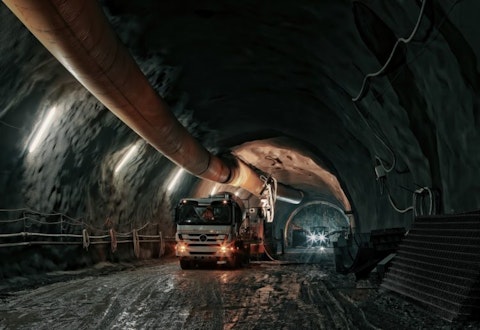ArcelorMittal S.A. (NYSE:MT) Q3 2022 Earnings Call Transcript November 10, 2022
ArcelorMittal S.A. misses on earnings expectations. Reported EPS is $1.11 EPS, expectations were $1.25.
Daniel Fairclough: Good afternoon, and good morning, everybody. Welcome to ArcelorMittal’s Third Quarter Analyst and Investor Call. This is Daniel Fairclough from the ArcelorMittal Investor Relations team. I’m joined on this call by our CFO, Genuino Christino. Before I hand over to Genuino, I would like to mention a few housekeeping items. Firstly, I want to refer everybody to the disclaimers that are on Slide 2 of the results presentation that we published on our website this morning. I’d also like to remind everyone that this call is being recorded and it’s scheduled to last up to 45 minutes. Finally, if you would like to ask a question, then please do press star one on your telephone keypad, and we will answer the questions in the order in which they received. With that, I would like to hand over the call to Genuino for some opening remarks.

Photo by Ricardo Gomez Angel on Unsplash
Genuino Christino : Thank you, Daniel, and thank you, and good afternoon, everybody. I will make some very brief remarks before we move to your questions. I have basically three main points to make. Firstly, on the current market situation. So, real demand headwinds are being exacerbated by destocking through the value chain. The destocking impact on the apparent demand is very significant, but we know from experience that it won’t last. This gives us confidence that the apparent demand conditions will improve once the destocking phase reaches maturity. My second point is on our response. We are responding effectively by adapting our capacity for quarter four and reducing fixed costs on the impacted tonnes. At current spot levels, variable costs and by that, I mean, raw materials and energy on a per tonne basis are expected to decline in Q4.
The improvements we have made in recent periods are being tested by this difficult market environment, but results should demonstrate that our business is stronger and more resilient. My final point is on the outlook. Significant cash has been allocated to working capital investment in recent quarters. This is now at peak, we believe, and the expected working capital unwind should support free cash flow in a lower EBITDA environment. Our balance sheet strength and expectation of consistently positive free cash flow underpin the continued execution of our strategy to grow and develop the business to be a safe leader in low carbon and steel and capture the growth opportunities in faster growing markets. With that brief opening, we are now ready, Daniel to take the questions.
See also The Future of Artificial Intelligence and 20 Biggest Employers in the World.
A – Daniel Fairclough: Great. Thank you, Genuino. We will take that for the first question, please, from Alain at Morgan Stanley.
Alain Gabriel: Thanks, Daniel. Hi, Genuino. Thank you. Two questions from my side. The first one is on the profit bridges for Q4. So besides the price indicators that we can see on our screens, what are the less obvious moving parts that we need to consider if we’re thinking about the EBITDA bridges into next quarter? And perhaps an overview by division would be most helpful. That’s my first question. Thank you.
Genuino Christino : Thank you, Alain. Alain, I think as I see quarter four right now, we’re going to continue to see, to some extent, some of the same factors that we saw in quarter three. Probably the most important aspect of the quarter will be the destocking that we expect will continue and probably accelerate. As a result, we will continue to see shipments being at the reduced levels that we saw in quarter three. On a divisional basis, we should be slightly lower in Europe and not really much, but slightly low in Europe. And in the other divisions, my expectation is that we’re going to be relatively flat, which I think it’s a good sign. So prices, we know spot prices have declined during the quarter. It will impact our realized prices in quarter four.
But more on the positive side, of course, raw materials are also coming down. We saw iron ore prices down. We saw our coking price is quite significantly down during quarter three. And in Europe, as we know, energy prices have come down quite significantly from big levels that we saw in August. So that should help profitability, of course, in Q4. And then, of course, we have to see what happens beyond that. It has been very volatile. We have seen, as you know, price is reaching at big levels. Yes, price is more than €350 per megawatt. And during a few days recently, we saw prices as low as €7. So we’ll see. But we have a combination of destocking impacting the apparent steel demand. And I would also like to say that in Europe, the real demand up to Q3 has actually been okay, has not really been the problem.
The problem has really been the destock that really started in Q3, and we expect to accelerate in Q4. I will stop here and see if you have any follow-ups.
Q&A Session
Follow Arcelormittal S A Luxembourg (NYSE:MT)
Follow Arcelormittal S A Luxembourg (NYSE:MT)
Receive real-time insider trading and news alerts
Alain Gabriel: Thank you. That’s my first question. The second question is on working capital and capital returns. If we assume that the current spot prices persist, how much do you think you will be able to release in working capital in Q4 and throughout the balance of next year, out of the €10 billion that you built? And if your free cash flow consisted entirely of working capital release next year, would that give you enough confidence to continue your buyback program after May?
Genuino Christino: Yeah. On working capital, I mean, for sure, our expectation is to release working capital in quarter four. And actually in quarter three, looking only at inventories, we have destocked as well. The only reason why you still see an investment in Q3, is because the loss in payables was greater than the reduction in inventories, which is natural when you are at this point of the cycle where we are adjusting production, as you know, adjusting also our procurement, purchases. So we have that initial impact on payables. And then moving into quarter four, our expectation is that we will see significant release of working capital. And then in 2023, I think based on what we know today, looking at all the key lead indicators that we have, I think it’s a fair assumption that we’re going to also be releasing working capital in 2023.
I think it’s early days to say to try to quantify how much. But you know very well. So up to now, in the last seven quarters, we have invested $10 billion, so that is there. It’s money that it’s on our balance sheet. And if market conditions remain challenging and we are in an environment of lower prices, then I think it’s a fair expectation that the company will release our working capital next year should provide a good cushion to free cash flow as we have been saying consistently. And our intention is to keep our capital allocation policy. So to the extent that we generate the free cash flow next year, then I think you should expect that the company will just continue apply a policy that’s so far we see has been very successful.
Alain Gabriel: Thank you.
Operator: Thanks Alain. So we’ll move to the next question please from Tristan at BNP Paribas. Go ahead Tristan.
Tristan Gresser: Yes, hi. Thank you for taking my questions. Maybe the first one, I think, pushing a bit on the guidance. Last time during COVID, we also had volumes falling significantly in a high level of uncertainty. And at the time you provided some helpful EBITDA guidance range. Is there may be a range you could share for Q4, or maybe if you could tell us if you feel comfortable with current consensus for the full year at $14 billion? Thank you.
Daniel Fairclough: Yes, I think as you know, we don’t really provide that quantitive guidance for EBITDA, the circumstances are very, very different. I don’t think we can compare what we have today, what we had back in 2020. So, I will not be running to providing very specific guidance, sorry for that.
Tristan Gresser: All right. Fair enough. So, the second question maybe on the Kazakhstan operations. First, can you give us an update on the situation. I’ve seen in the release that volumes have picked up. So, how is the split between profitability between Ukraine, Kazakhstan South Africa in Q3? How you expect moving that forward? And more long-term question, given your focus on sustainability and safety and especially now given the context in the CIS region, how do you view your operation in Kazakhstan? How strategic are they? And is the objective to invest more there, or at some point, maybe consider other options? Thank you.



